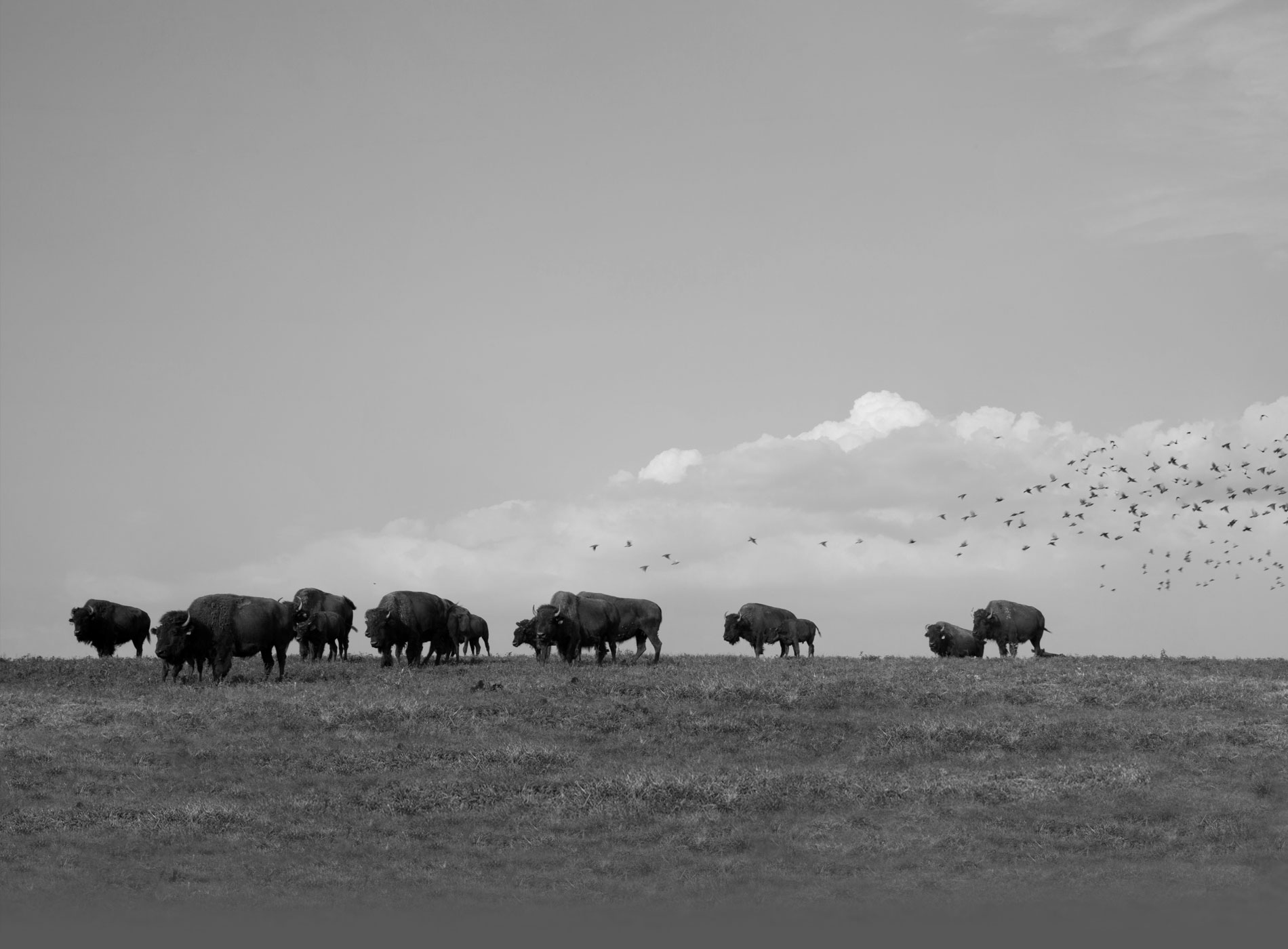Dahlia are a wonderful addition to any garden. Their uses are limitless and allow you the freedom to change your garden design year to year. We use them in our perennial border, shrub border, vegetable garden, and even in mixed pots. Although not winter hardy (USDA Zone 8 ) in our area (USDA Zone 6)–they require lifting and storage for winter–the dahlia is tender with an attitude. As the blooms of many of our perennial standouts peter out with the first few cold snaps and light frosts, the dahlia’s colors become more vibrant. With 6 months or more growth the hollow stems hold their delicate blooms high and proud, daring mother nature to bring the killing frost we all know will come–but when? These bold colors coax one into the garden on finger-numbing mornings reminding us that the growing season is not over.
 There is a seemingly endless list of dahlia types, which are classified by petal arrangement and the shape of the flower. Each type varies in bloom size, plant height, appearance, and vase life. A wonderful addition to flower arrangements, the double-flowering types do best as single-flowering blooms tend to drop their petals. We make sure to keep cut dahlias on display in the main house throughout the fall. I am currently keeping a close eye on the weather forecast for the cold snap that will end their season, and have big plans to cut every dahlia bloom to fill the house.
There is a seemingly endless list of dahlia types, which are classified by petal arrangement and the shape of the flower. Each type varies in bloom size, plant height, appearance, and vase life. A wonderful addition to flower arrangements, the double-flowering types do best as single-flowering blooms tend to drop their petals. We make sure to keep cut dahlias on display in the main house throughout the fall. I am currently keeping a close eye on the weather forecast for the cold snap that will end their season, and have big plans to cut every dahlia bloom to fill the house.
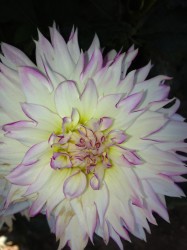
Once a killing frost arrives we will cut the stems to approximately 3″ above the ground and mark with a descriptive tag. Using a garden fork, we will dig each clump while taking care to avoid spearing the tubers. Gently shaking and brushing the soil from each clump, a descriptive tag is tied to the stem to guarantee identification in the spring. The clumps are placed on a shelf to cure for a few days before being moved to winter storage.
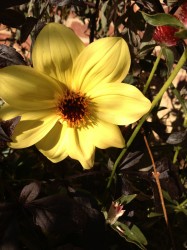
For storage, we use leftover sawdust from our sawmill, plastic zipper bags and bulb crates. After curing for a few days, each clump is inspected for wounds and signs of disease. It is recommended that wounded areas be dusted with sulfur to inhibit disease, but to date we have not taken this step in our overwintering process; instead we check the stored tubers every few weeks for adequate moisture and signs of disease. Diseased tubers are removed immediately. If the sawdust becomes dry, water is sprinkled in each bag to avoid drying out of the tubers. The crates of tubers are stored in an area where the temperature is not allowed to dip below 38 degrees or above 50 degrees.

Throughout the winter, as we check the tubers, I gaze at the laminated photos attached to each bag and imagine where that dahlia will live next season. I know already that ‘Crazy Love’ will end up in a container or two, and ‘Gallery Art Deco’–a gift from Katie Kramer–will go back in the shrub border again.
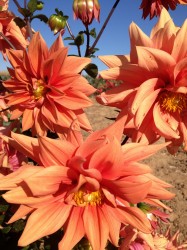 Appreciating what is in the garden now and dreaming of next year is a wicked balancing act. Beautiful gardens are made with planning, but accidents are often welcome additions. We will pot up our dahlia tubers in April to assist with planning and placement in May; however, this is not a necessary step as they can be planted directly in the ground within a week or so of the last spring frost date–about the time you might plant tomatoes.
Appreciating what is in the garden now and dreaming of next year is a wicked balancing act. Beautiful gardens are made with planning, but accidents are often welcome additions. We will pot up our dahlia tubers in April to assist with planning and placement in May; however, this is not a necessary step as they can be planted directly in the ground within a week or so of the last spring frost date–about the time you might plant tomatoes.


 It is through the Mesonet site that the current temperature and conditions at Woodland are displayed on our homepage. The Mesonet station for Oldham County is located atop a bison pasture.
It is through the Mesonet site that the current temperature and conditions at Woodland are displayed on our homepage. The Mesonet station for Oldham County is located atop a bison pasture.



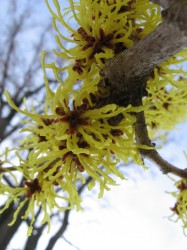
 Hamamelis x intermedia ‘Arnold Promise’ is in full glorious bloom. The flowers of this witchhazel resemble perfect lemon zests draped over its rust-red calyx. A deer favorite, it is only in the last few years that we have been able to enjoy this fireworks display. Fencing special plants can be a nuisance and an eyesore but when you are rewarded with blooms like this, it is obviously time well spent. The warm weather has definitely played a part in this early bloom. Phenology geeks pay attention as we are 4 weeks ahead of 2010 and 2011.
Hamamelis x intermedia ‘Arnold Promise’ is in full glorious bloom. The flowers of this witchhazel resemble perfect lemon zests draped over its rust-red calyx. A deer favorite, it is only in the last few years that we have been able to enjoy this fireworks display. Fencing special plants can be a nuisance and an eyesore but when you are rewarded with blooms like this, it is obviously time well spent. The warm weather has definitely played a part in this early bloom. Phenology geeks pay attention as we are 4 weeks ahead of 2010 and 2011.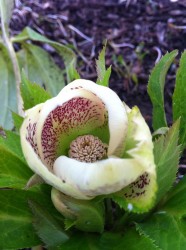
 I believe my friend Natalie was right when she posted “Winter is canceled” on her facebook page. Signs of this are showing up every day. The daffodil and tulip foliage have been peeking up for weeks and the fall planted pansies haven’t stopped blooming.
I believe my friend Natalie was right when she posted “Winter is canceled” on her facebook page. Signs of this are showing up every day. The daffodil and tulip foliage have been peeking up for weeks and the fall planted pansies haven’t stopped blooming.
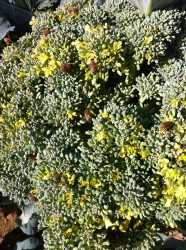

 r and more vibrant. The amazing red of the dinner plate Dahlia ‘Babylon Red’ against the striking backdrop of Anemone ‘Party Dress’ (Pictured right) is a sight not to be missed. Although we have to lift the dahlia tubers each season, we leave them in the ground for as long as possible–clinging to the colors they display for as long as we can. Other Dahlia varieties that keep us in color include: Babylon Purple, Bishop of Llandoff, Crazy Love, D. soldera, Karma Corona, Kelvin Floodlight, Nuit d’Ete and a few more. These guys aren’t the only show stoppers.
r and more vibrant. The amazing red of the dinner plate Dahlia ‘Babylon Red’ against the striking backdrop of Anemone ‘Party Dress’ (Pictured right) is a sight not to be missed. Although we have to lift the dahlia tubers each season, we leave them in the ground for as long as possible–clinging to the colors they display for as long as we can. Other Dahlia varieties that keep us in color include: Babylon Purple, Bishop of Llandoff, Crazy Love, D. soldera, Karma Corona, Kelvin Floodlight, Nuit d’Ete and a few more. These guys aren’t the only show stoppers.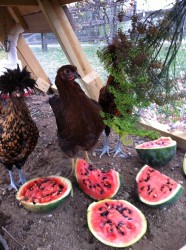
 I’m sure the title of this post made your mouth water. Visions of beautifully glazed chicken with a sweet watermelon sauce beginning to form in your mind?
I’m sure the title of this post made your mouth water. Visions of beautifully glazed chicken with a sweet watermelon sauce beginning to form in your mind?


